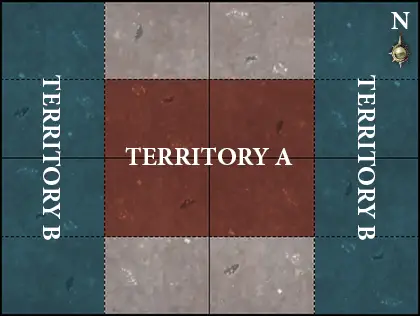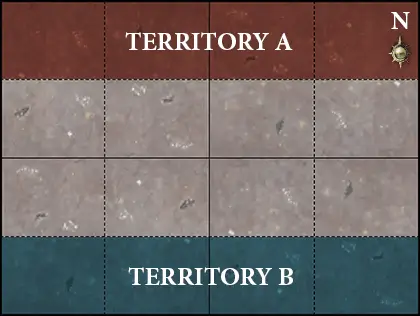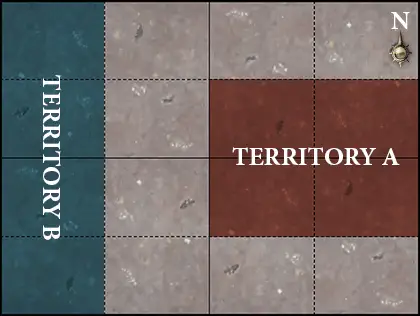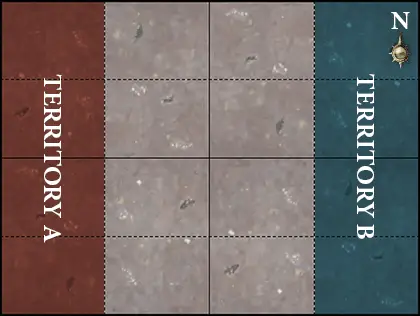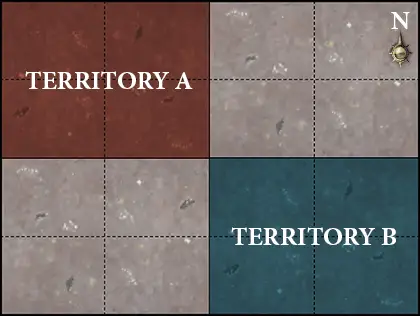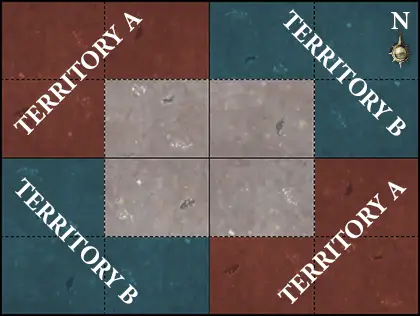Open Play Games
Open play is the default setting for games of Warhammer Age of Sigmar. It allows you to set up and play a game with the minimum amount of fuss and preparation, while providing you with almost limitless options and flexibility.
Contents | ||
In open play, there are no restrictions on which models you can include in your army or whether the units in your army must belong to a single faction - all you need to do is agree with your opponent on the points limit for the game. You are then free to use whichever models you like, so long as the combined points value of your army does not go beyond that limit. For example, you can field an army consisting entirely of monsters or heroes, or, if your collection comprises Stormcast Eternals and Ossiarch Bonereapers, you can field them all together. The ability to play games using any of your miniatures is the spirit of open play.
The flexibility of open play makes it the ideal choice if you are one of the many people for whom the main appeal of Warhammer Age of Sigmar is simply collecting and painting Citadel Miniatures. Open play allows you to have some fun with your collection on the tabletop without having to follow the army-selection rules that apply in narrative and matched play.
With this freedom comes a certain amount of responsibility, of course, and open play gamers usually therefore take it as a badge of honour not to just field the most powerful models in their collection. Instead, open play armies will usually have a strong theme based on the background of the Mortal Realms, and will often be lovingly painted. After all, one of the best aspects of open play is that it allows players to use their display collections of Citadel Miniatures in a game, and so the models will look as good on the battlefield as they do in the cabinet - if not better, arrayed for battle in all their glory!
While the essence of open play is as simple as that, there are things you can do to add an extra dimension to your games, if you wish. Included in this section is the Open War battleplan generator, which will randomly create interesting open play battleplans for you to use. However, the contents of this section are just the beginning. The beauty of open play is that it’s a format limited only by your imagination. Using the tools presented on this page as your inspiration, you can explore the near-infinite wonders of the Mortal Realms on the tabletop, and play games with any of the amazing miniatures in the Warhammer Age of Sigmar range that you desire.
Books
| Book | Kind | Edition | Last update | |
 Warhammer Age of Sigmar: Core Rules Warhammer Age of Sigmar: Core Rules | ||||
 Warhammer Age of Sigmar: Core Rules Warhammer Age of Sigmar: Core Rules | Rulebook | 3 | February 2024 | |
OPEN WAR BATTLEPACK
The Open War battlepack is designed for players who like the simplicity of open play and are looking for as much variety in their games as possible. If you use it, no two games will ever be the same.Points Limit
The players must first agree on a points limit for the battle. The points limit can be any number and determines the number of points you have available to spend on your army. The points limit also determines the recommended minimum battlefield size and recommended minimum number of terrain features for the battle, as shown in the table below.
| ||||||||||||||||
| The points value of a unit can be found on its Pitched Battle profile (see section 25.4 of the core rules). | ||
| Remember that you can include 1 faction terrain feature in your army (see section 1.4.1 of the core rules). Faction terrain features do not cost any points. | ||
Faction Terrain
Faction terrain features are set up according to the rules in their faction’s battletome. If it is impossible for a faction terrain feature to be set up, then it is not used.Battalions
You can include warscroll battalions and core battalions in your army.The Battlefield
Before the battleplan is generated, the players roll off. The winner sets up the terrain features for the battlefield. The number of terrain features that are set up is determined by the size of the battlefield, as shown on the Open War table.Terrain features must be set up more than 3" from the edge of the battlefield and more than 6" from all other terrain features. If it is impossible for a terrain feature to be set up, it is not used.
Open War Battleplan Generator
The battleplan for an Open War battle is generated using the Open War battleplan generator. The battleplan generator is made up of four tables, which determine where the armies are set up (the Map table), what the players must do in order to win the battle (the Victory table), and the special rules that apply to the battle (the Twist and Ruse tables). After the players have picked their armies, resolve the following steps to generate the battleplan:1. MAP
One player rolls on the Map table. The result is the map for the battle.2. VICTORY
The players roll off. The winner rolls on the Victory table. If the result requires objectives to be set up, the player that rolled on the table does so now.3. TWIST
One player rolls on the Twist table. The result applies to both players for the duration of the battle.4. RUSE
Keeping their roll hidden from their opponent, each player rolls on the Ruse table. Each result only applies to the player who rolled it. Ruses do not need to be revealed until they are used.| When rolling on the Ruse table, we recommend hiding the dice under an upturned cup. Reveal your roll to your opponent when you want to use the ruse. | ||
Deployment
After the battleplan has been generated, the player who did not set up the battlefield’s terrain features chooses which player uses Territory A and which player uses Territory B, and which long edge of the battlefield is the northern edge. The players then alternate setting up units one at a time, starting with the player who won the roll-off to set up the terrain features. Each player must set up their units wholly within their territory and more than 6" from their opponent’s territory.The players continue to set up units until both armies have been set up. If one player finishes setting up their army first, their opponent must set up the rest of the units in their army, one after another.
Game Length
The battle ends at the end of the fifth battle round unless noted otherwise in the victory condition.Map Table
|
|
Victory Table
|
Ruse Table
| Before the battle, each player rolls on the Ruse table. Your ruse may prove to be a valuable ‘ace in the hole’ when you need it the most! | ||
|
Twist Table
| The twist is a rule that applies to each player during the battle. The twist can have a significant impact on the battle, depending on the types of units the players have included in their armies. | ||
|
Arcane Prize Table
| The Arcane Prize table is only used if you roll the ‘Arcane Prize’ result on the Victory table. The true nature of the prize is only revealed once one army seizes it. As always, there is a certain amount of risk involved in meddling with ancient relics... | ||
|
1.5.3 Rolling Off
Sometimes a rule may require the players to roll off. To roll off, each player rolls a dice, and whoever rolls highest wins. If a roll-off is tied, roll off again. You cannot re-roll or modify the dice when you roll off.
3.1 Reserve Units and Summoned Units
Sometimes a rule will allow you to set up a unit in a location other than the battlefield as a reserve unit. A unit that is added to your army once the battle is underway is called a summoned unit.When you set up a reserve unit, either during deployment or once the battle is underway, you must tell your opponent that the unit is in reserve and keep it to one side instead of placing it on the battlefield. At the start of the fourth battle round, units that are still in reserve are destroyed. Units cannot cast spells or use abilities while they are in reserve unless the spell or ability specifically says it can be used by reserve units.
| Reserve units are picked as part of your army before the battle begins, while summoned units are units added to your army once the battle is underway. Models that have been removed from play can be used as part of a summoned unit. | ||
1.4.2 Your General
After you have picked your army, you must pick 1 model in your army to be your general. Generals are used to generate command points (see 6.0).
Wound Roll
Roll a dice. If the roll equals or beats the attacking weapon’s To Wound characteristic, the attack wounds the target and your opponent must make a save roll. If not, the attack fails and the attack sequence ends. An unmodified wound roll of 1 always fails and an unmodified wound roll of 6 always wounds. A wound roll cannot be modified by more than +1 or -1 (this is an exception to the principle that abilities take precedence over core rules).
15.1 Battleshock Tests
You must make a battleshock roll for each friendly unit that has to take a battleshock test. To make a battleshock roll, roll a dice and add the number of models in the unit that were slain in that turn to the roll. If the battleshock roll is greater than the unit’s Bravery characteristic, the battleshock test has been failed. If the test is failed, for each point by which the battleshock roll exceeds the unit’s Bravery characteristic, 1 model in that unit must flee. You decide which models flee. A model that flees is removed from play.| If a slain model is returned to its unit in the same turn that it is slain, it still counts as having been slain in that battle round for the purposes of battleshock tests. | ||
14.5 Mortal Wounds
Some attacks, spells and abilities cause mortal wounds. Do not make hit, wound or save rolls for mortal wounds. Instead, the damage inflicted on the target is equal to the number of mortal wounds that were caused.Mortal wounds caused while a unit is attacking are allocated at the same time as wounds caused by the unit’s attacks: after all of the unit’s attacks have been made. Mortal wounds caused at other times are allocated as soon as they are caused. Mortal wounds are allocated in the same way as wounds and are treated in the same manner as wounds for rules purposes.
8.3 Run
When you pick a unit to run, you must make a run roll for the unit by rolling a dice. Add the run roll to the Move characteristic of all models in the unit until the end of that phase. You can then move each model in that unit a distance in inches equal to or less than their modified Move characteristic. No part of a run can be within 3" of an enemy unit. You cannot shoot or attempt a charge later in the turn with a unit that has run. Units cannot run if they are within 3" of an enemy unit.
11.1 Charge Moves
When you attempt a charge with a unit, make a charge roll for the unit by rolling 2D6. You can then make a charge move with each model in that unit by moving the model a distance in inches that is equal to or less than the charge roll. The first model you move in a unit attempting a charge must finish the move within 1/2" of an enemy unit. If this is impossible, no models in the unit can make a charge move.| You do not have to pick a target for a charge attempt before making the charge roll. | ||
14.4 Healing Wounds
Some abilities allow you to heal wounds that have been allocated to a model. For each wound that is healed, reduce the number of wounds allocated to the model by 1, to a minimum of 0. You cannot heal wounds on a model that is slain.
Hit Roll
Roll a dice. If the roll equals or beats the attacking weapon’s To Hit characteristic, the attack scores a hit and you must make a wound roll. If not, the attack fails and the attack sequence ends. An unmodified hit roll of 1 always fails and an unmodified hit roll of 6 always hits. A hit roll cannot be modified by more than +1 or -1 (this is an exception to the principle that abilities take precedence over core rules).Sometimes an ability will allow a single hit roll to score two or more hits. If this is the case, make all of the wound and save rolls for those hits at the same time.
19.1 Casting Spells
In your hero phase, you can attempt to cast spells with friendly WIZARDS. You cannot attempt to cast the same spell more than once in the same hero phase, even with a different WIZARD. In order to attempt to cast a spell, pick a friendly WIZARD, say which of the spells that they know will be attempted, and then make a casting roll by rolling 2D6. If the casting roll is equal to or greater than the casting value of the spell, the spell is successfully cast.
